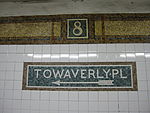Eighth Street–New York University station
8 Street–New York University X28 | ||||||||||||||||||||||||||||||||||||||||||||||||||||||||||||||||||||
|---|---|---|---|---|---|---|---|---|---|---|---|---|---|---|---|---|---|---|---|---|---|---|---|---|---|---|---|---|---|---|---|---|---|---|---|---|---|---|---|---|---|---|---|---|---|---|---|---|---|---|---|---|---|---|---|---|---|---|---|---|---|---|---|---|---|---|---|---|
| Structure | Underground | |||||||||||||||||||||||||||||||||||||||||||||||||||||||||||||||||||
| Platforms | 2 side platforms | |||||||||||||||||||||||||||||||||||||||||||||||||||||||||||||||||||
| Tracks | 4 | |||||||||||||||||||||||||||||||||||||||||||||||||||||||||||||||||||
| Other information | ||||||||||||||||||||||||||||||||||||||||||||||||||||||||||||||||||||
| Opened | September 4, 1917[2] | |||||||||||||||||||||||||||||||||||||||||||||||||||||||||||||||||||
| Opposite- direction transfer | No | |||||||||||||||||||||||||||||||||||||||||||||||||||||||||||||||||||
| Former/other names | 8th Street-NYU | |||||||||||||||||||||||||||||||||||||||||||||||||||||||||||||||||||
| Traffic | ||||||||||||||||||||||||||||||||||||||||||||||||||||||||||||||||||||
| 2023 | 3,531,009[3] | |||||||||||||||||||||||||||||||||||||||||||||||||||||||||||||||||||
| Rank | 99 out of 423[3] | |||||||||||||||||||||||||||||||||||||||||||||||||||||||||||||||||||
| ||||||||||||||||||||||||||||||||||||||||||||||||||||||||||||||||||||
| ||||||||||||||||||||||||||||||||||||||||||||||||||||||||||||||||||||
| ||||||||||||||||||||||||||||||||||||||||||||||||||||||||||||||||||||
| ||||||||||||||||||||||||||||||||||||||||||||||||||||||||||||||||||||
| ||||||||||||||||||||||||||||||||||||||||||||||||||||||||||||||||||||
The Eighth Street–New York University station (sometimes shortened as 8th Street–NYU) is a local
History
Construction and opening
The
The Brooklyn Rapid Transit Company submitted a proposal to the Commission, dated March 2, 1911, to operate the Tri-borough system (but under Church Street instead of Greenwich Street), as well as a branch along Broadway, Seventh Avenue, and 59th Street from Ninth Street north and east to the
A short portion of the line, coming off the north side of the Manhattan Bridge through Canal Street to
Later years
The station's platforms originally could only fit six 67-foot-long (20 m) cars. In 1926, the New York City Board of Transportation received bids for the lengthening of platforms at nine stations on the Broadway Line, including the Eighth Street station, to accommodate eight-car trains. Edwards & Flood submitted a low bid of $101,775 for the project.[10] The platform-lengthening project was completed in 1927, bringing the length of the platforms to 535 feet (163 m).[11][12]
The city government took over the BMT's operations on June 1, 1940.[13][14] The station's overhaul in the late 1960s included extending the station platforms required for 10 car trains, and fixing the station's structure and the overall appearance (including the staircases and platform edges), replacing the original wall tiles, old signs, and incandescent lighting to the 70's modern look wall tile band and tablet mosaics, signs and fluorescent lights.
In 2001, the station received a state of repairs including upgrading the station for
In 2005, the artwork Tim Snell's Broadway Diary mosaics installed on the station platform wall titles in both directions.
Station layout

| Ground | Street level | Exit/entrance |
| Platform level | Side platform | |
| Northbound local | ← ← ← ← | |
| Northbound express | ← | |
| Southbound express | | |
| Southbound local | | |
| Side platform | ||
This underground station has four tracks and two side platforms. The inner two tracks are express tracks that do not serve the station.
Exits
The staffed
Near the southern ends of each platform, one stair ascends from each platform to an intermediate landing on each side. Each landing has an exit-only turnstile and a
References
- ^ "Glossary". Second Avenue Subway Supplemental Draft Environmental Impact Statement (SDEIS) (PDF). Vol. 1. Metropolitan Transportation Authority. March 4, 2003. pp. 1–2. Archived from the original (PDF) on February 26, 2021. Retrieved January 1, 2021.
- ^ "Open First Section of Broadway Line". The New York Times. September 5, 1917.
- ^ a b "Annual Subway Ridership (2018–2023)". Metropolitan Transportation Authority. 2023. Retrieved April 20, 2024.
- ^ "Annual Subway Ridership (2018–2023)". Metropolitan Transportation Authority. 2023. Retrieved April 20, 2024.
- ^ James Blaine Walker, Fifty Years of Rapid Transit, 1864–1917, published 1918, pp. 207-223
- ^ Engineering News, A New Subway Line for New York City, Volume 63, No. 10, March 10, 1910
- ^ James Blaine Walker, Fifty Years of Rapid Transit, 1864–1917, published 1918, pp. 224-241
- ^ "Broadway Subway Opened To Coney By Special Train. Brooklynites Try New Manhattan Link From Canal St. to Union Square. Go Via Fourth Ave. Tube". The Brooklyn Daily Eagle. September 4, 1917. Retrieved May 31, 2019.
- ISSN 0362-4331. Retrieved November 5, 2016.
- ISSN 0362-4331. Retrieved 2023-04-28.
- ISSN 0362-4331. Retrieved 2023-05-12.
- ProQuest 1113704092.
- from the original on July 19, 2021. Retrieved 2022-05-14.
- ProQuest 1243059209.
- ^ a b "MTA Neighborhood Maps: East Village" (PDF). Metropolitan Transportation Authority. 2015. Retrieved August 6, 2015.
External links
- nycsubway.org – BMT Broadway Subway: 8th Street
- Station Reporter – N Train
- Station Reporter – R Train
- Flickr – Photo of Tim Snell's Cube mural
- Wired New York Forum – Subway mosaics and their artists
- MTA's Arts For Transit – 8th Street–NYU (BMT Broadway Line)
- Eighth Street entrance from Google Maps Street View
- Waverly Place entrance from Google Maps Street View
- Platforms from Google Maps Street View






